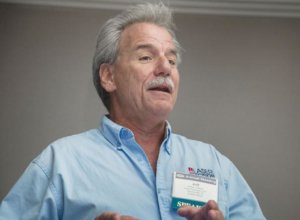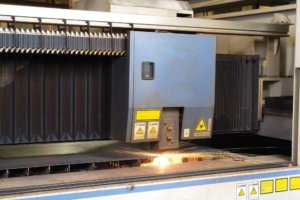Laser Precision: Building the Foundation of Success
February 14, 2018

What does it take to drive innovation in a competitive industry like sheet metal and plate fabrication? It takes inspiration, a bit of perspiration and, frankly, a healthy dose of dedication and commitment. In 1982, Jeff Adams was a recent graduate of a small Midwestern college with a fresh degree in political science. Purely by coincidence, he was invited by an engineer friend to tour a machine shop that was performing tool and die work for metal stamping operations. As they walked through the rows of machines and workers in the tool and die shop, the engineer turned to Jeff and said, “Just think. Someday, all of this stuff will be done by lasers.”
Jeff instantly knew that his friend’s prediction represented a new paradigm of advanced manufacturing. His insight illuminated new avenues of discussion and recognition that the manufacturing world would become a very different place. The only question was how to get there first.
 Already interested in science as well as his chosen major, Jeff spent the next several years educating himself in physics, optical theory, and the fundamentals of laser design and operation. By 1986, he had landed a job with a major laser manufacturing corporation, which had introduced its first laser cutting machine just a couple of years earlier. While working there, he came to understand the magnitude of the change that was underway. It became clear that changes in the macro economy would put demands on manufacturing that would require new strategies and technologies to foster competition on the world stage – The Age of Flexible Manufacturing was dawning.
Already interested in science as well as his chosen major, Jeff spent the next several years educating himself in physics, optical theory, and the fundamentals of laser design and operation. By 1986, he had landed a job with a major laser manufacturing corporation, which had introduced its first laser cutting machine just a couple of years earlier. While working there, he came to understand the magnitude of the change that was underway. It became clear that changes in the macro economy would put demands on manufacturing that would require new strategies and technologies to foster competition on the world stage – The Age of Flexible Manufacturing was dawning.
As a National Sales Rep for the company, Jeff was tallying up huge travel time (over 200,000 miles annually) and adding to his knowledge about using lasers and automation in the manufacturing process. As part of his duties, he was fortunate to develop a business association with Terry Mahuron, the President of Serra Corporation, a major manufacturer of sheet metal parts. Terry was a visionary within the metal fabrication industry and had a well-deserved reputation for his brilliance and foresight. The two men forged a relationship that would eventually lead to a business partnership.
With Terry providing crucial insights into challenges and opportunities within American manufacturing, the pair spent many hours discussing the coming market evolution and how lasers and advanced automation would play a role. Over the course of these talks, it became clear that they had a similar vision for the future of the industry and the opportunities that existed.
Ups and Downs
 Eventually, as the travel miles continued to mount and his children grew older, Jeff made the call to Terry and proposed the two enter into a business venture. Laser Precision was opened for business in the autumn of 1994 with Terry as the major investor. Terry’s role, in addition to providing seed capital, was to foster the growth of the organization through his vast experience in metal fabrication and his vision for the future. Jeff provided a detailed knowledge of the applications and technologies, and also functioned as the operational manager.
Eventually, as the travel miles continued to mount and his children grew older, Jeff made the call to Terry and proposed the two enter into a business venture. Laser Precision was opened for business in the autumn of 1994 with Terry as the major investor. Terry’s role, in addition to providing seed capital, was to foster the growth of the organization through his vast experience in metal fabrication and his vision for the future. Jeff provided a detailed knowledge of the applications and technologies, and also functioned as the operational manager.
It was Jeff’s vision from the start to eventually be a full end fabricator. The company started working with top level OEMs and other metal fabricators that were outsourcing parts of their operations. Laser operations came first with one machine and then another. Machining and forming were added a couple years later, with welding following close behind. As the business grew, it began migrating more into the OEM operations.
 Under their stewardship, the footprint of the company gradually grew from 4,000 square feet to 12,000 to 40,000. In 2007, the company moved to its current location in Libertyville, Illinois, starting with 60,000 feet and eventually adding 70,000 more.
Under their stewardship, the footprint of the company gradually grew from 4,000 square feet to 12,000 to 40,000. In 2007, the company moved to its current location in Libertyville, Illinois, starting with 60,000 feet and eventually adding 70,000 more.
The firm had become a large vendor of an American Fortune 100 corporation that designs, manufactures, and sells heavy-duty construction equipment. It was there that Terry and Jeff identified the need for a new framework in the metal fabrication business. It was clear that the rapid adoption of data-centric resource planning systems in large manufacturing companies was presenting both a barrier to growth and a challenge to performance. Vast amounts of data were being conveyed to the vendor base, yet no one had the capacity to interpret and deploy the information on a timely basis.
Engineering Better Service
Laser Precision had already been thinking of ways to achieve even better delivery times and reduce the number of defective parts per million shipped (ppm). After the recognition of the need for better information management systems, experiments with advanced data management systems began. They started by trying to capture the information manually, which led them to rethink the whole concept of data processing. Version after version was tried, and while providing some success in the shop, the manual system was consuming up to two cases of paper a week. Clearly, the capacity to manage the vast sums of information was beyond any reasonable human capacity. It could probably be done, but no one could afford the cost.
The engineering team came to the conclusion that if the limits to growth were to be removed, it would be necessary to develop intelligent computer systems to coordinate the value stream and key performance elements. The recognition of this requirement drove the organization to develop the tools and processes that now allow Laser Precision to achieve the World Class results they produce on a daily basis.
Learn how our data best practices helped us evolve into the Laser Precision you know today. Read “Data That Doesn’t Lead to Action is Useless” and “How We Converted Reams of Raw Data Into Stacks of Completed Orders.”

